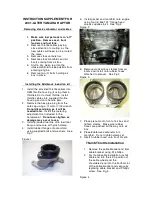
6-28
CAUTION:
Turning the radiator pressure cap when the
engine and radiator are hot can allow steam
and scalding liquids to blow out and burn you
badly. With the coolant recovery tank, you will
almost never have to add coolant at the radiator.
Never turn the radiator pressure cap
--
even a
little
--
when the engine and radiator are hot.
CAUTION:
You can be burned if you spill coolant on hot
engine parts. Coolant contains ethylene glycol,
and it will burn if the engine parts are hot
enough. Don’t spill coolant on a hot engine.
Occasionally check the coolant level in the radiator. For
information on how to add coolant to the radiator, see
“Cooling System” in the Index.
Radiator Pressure Cap
NOTICE:
Your radiator cap is a 15 psi (105 kPa)
pressure
-
type cap and must be tightly installed to
prevent coolant loss and possible engine damage
from overheating. Be sure the arrows on the cap
line up with the overflow tube on the radiator
filler neck.
The radiator pressure cap is located near the front
of the engine compartment on the passenger’s side
of the vehicle.
See “Engine Compartment Overview” in the Index for
more information on location.
Summary of Contents for 2002 Regal
Page 1: ......
Page 6: ...v These are some examples of vehicle symbols you may find on your vehicle ...
Page 253: ...5 37 NOTES ...
Page 254: ...5 38 NOTES ...
Page 317: ...6 63 GM Vehicle Care Appearance Materials ...
Page 333: ...Scheduled Maintenance 7 7 ...
Page 334: ...Scheduled Maintenance 7 8 ...
Page 351: ...7 25 Maintenance Record DATE ODOMETER READING SERVICED BY MAINTENANCE PERFORMED ...
Page 352: ...7 26 Maintenance Record DATE ODOMETER READING SERVICED BY MAINTENANCE PERFORMED ...
Page 353: ...7 27 Maintenance Record DATE ODOMETER READING SERVICED BY MAINTENANCE PERFORMED ...
Page 354: ...7 28 Maintenance Record DATE ODOMETER READING SERVICED BY MAINTENANCE PERFORMED ...
Page 355: ...7 29 Maintenance Record DATE ODOMETER READING SERVICED BY MAINTENANCE PERFORMED ...
Page 356: ...7 30 Maintenance Record DATE ODOMETER READING SERVICED BY MAINTENANCE PERFORMED ...
















































